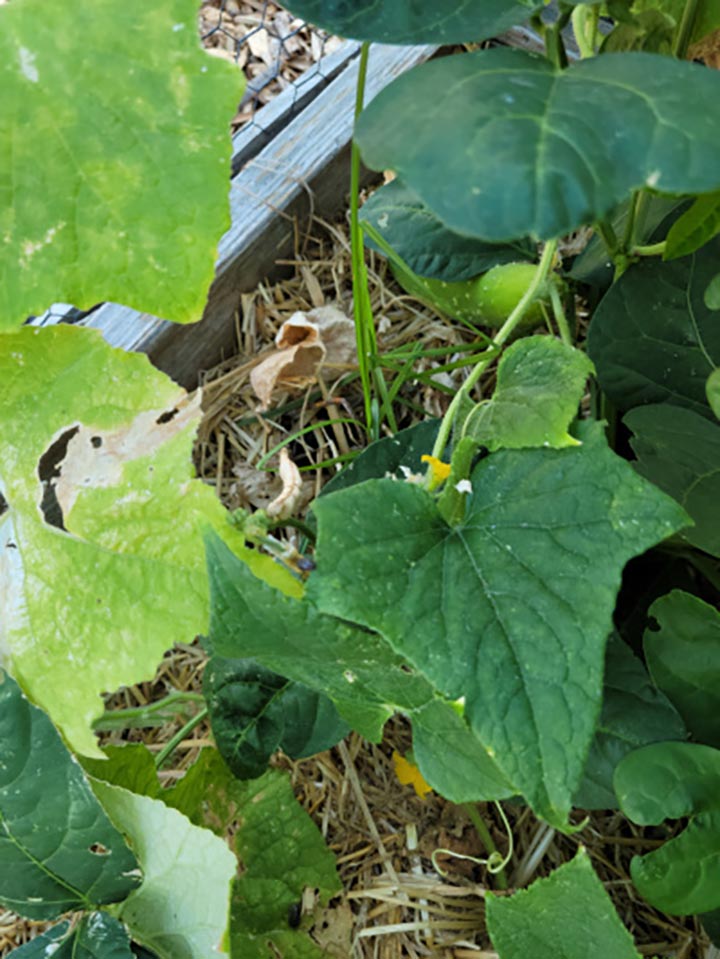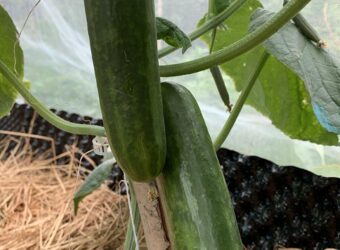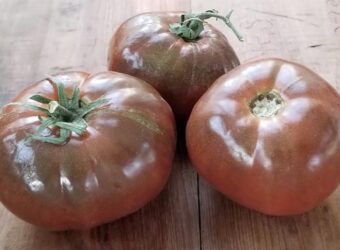Cucumbers are good for you and easy to grow. Every vegetable garden should have a cucumber vine or two. If you are growing cucumbers in your garden, you may wonder, What is the best cucumber fertilizer?
I have found cucumber fertilizers change depending on soil type and the growing stage the cucumber is in. Finding the right fertilizer for your cucumbers can be confusing. With my years of experience growing cucumbers in the garden, I have picked the five best fertilizers for your cucumbers so you know what to use and when.
Here are my picks for the best cucumber fertilizers.
- Neptune’s Harvest Tomato & Veg Fertilizer 2-4-2 – best liquid and fish fertilizer for cucumbers
- Jobe’s Organics, 06028, Fertilizer Spikes – best container fertilizer for cucumbers
- Dr. Earth Organic 5 Tomato, Vegetable & Herb Fertilizer – best organic fertilizer for cucumbers
- Miracle-Gro Water Soluble Plant Food Vegetables & Herbs – best water-soluble fertilizer for cucumbers
- Espoma Organic Garden-Tone 3-4-4 Organic Fertilizer – best overall fertilizer for cucumbers
Why Fertilize Cucumbers?
Cucumbers need a lot of water and nutrients to make the water-filled cucumbers we enjoy. My soils do not have enough nutrients for the cucumber throughout its lifecycle, so I add fertilizer to help them grow.
Most soils cannot support cucumbers without supplemental fertilizer. My container cucumbers have to have fertilizer because the nutrients in the potting mix are used up quickly.
How Do I Know If My Cucumber Needs Fertilizer?
Cucumbers that need fertilizer are stunted, don’t grow well, may produce few flowers, and have small, bitter cucumbers. The leaves may turn yellow on the edges, then yellow all over. If all the nutrients in the soil are used, the cucumber can die.
I have found this happens more in containers than in the ground, but it can happen to cucumbers planted in the ground that has been used as a vegetable garden for many years with no effort to replace the nutrients in the soil.
What Nutrients Do Cucumbers Need?
Cucumbers need the same twelve nutrients that all plants need. Here are the nutrients and what they do.
Major Nutrients
These three nutrients are needed in large quantities by all plants, including cucumbers. The numbers on the fertilizer bag refer to these nutrients.
Nitrogen
Nitrogen is used in every cell in a cucumber plant’s body. It makes up plant proteins, some plant hormones, and chlorophyll. Without nitrogen, a cucumber cannot grow, flower, or produce cucumbers.
Because cucumbers use so much nitrogen, I apply it in small amounts throughout the cucumber plant’s life.
I have seen low nitrogen result in stunted growth, few flowers, few cucumbers, and an unhealthy plant.
Excess nitrogen results in large vines with lots of foliage but few flowers or cucumbers. In extreme cases, I have seen nitrogen burn roots and leaves and even kill a cucumber plant.
Phosphorous
Phosphorous helps trigger blooms and fruit set. Early in the cucumber plant’s life, phosphorous helps with strong roots and healthy plant growth. Phosphorous also helps transfer the sun’s energy into something the plant can use.
I have seen a lack of phosphorous result in stunted plants with poor roots and few blooms. On the other hand, too much phosphorus burns a plant’s roots and leaves and even kills it.
Potassium
Potassium helps produce healthy plants that can resist diseases. This element also forms and moves starches, sugars, and oils throughout the plant. The right amount of potassium can improve the quality of your cucumbers, too.
I have seen plants that are not getting enough potassium with leaves that are yellow on the edges. Plants that are getting too much potassium have trouble absorbing the nitrogen and phosphorous available to them.
Minor Nutrients
Cucumbers need these nutrients in smaller amounts, but they are still important.
- Calcium – helps plants grow roots, new root hairs, and grow new leaves. Calcium is not as important in cucumbers in preventing blossom end rot as it is in tomatoes, but it is still important.
- Magnesium – is a key component of chlorophyll. Without magnesium, plants can’t convert sunlight into the energy they need.
- Sulfur – is one of the components of the ammo acids in plant proteins. Without enough sulfur, the plant can’t make the proteins it needs to build cell walls and grow.
Trace Elements
Cucumbers need these elements in trace amounts.
- Iron – helps cucumber vines regulate and promote growth.
- Manganese – is another element involved in photosynthesis.
- Zinc – creates a plant hormone that triggers stem and leaf growth.
- Copper – is part of plant enzymes.
- Boron – helps growing tissues form cell walls. Deficiencies affect the uptake and use of calcium, while too much boron is toxic.
- Molybdenum – does two things. It is essential for the cucumber plant to form proteins from nitrogen. Molybdenum also helps soil microbes convert the nitrogen in the air into a form the cucumber plant can use.
Things to Consider When Buying Cucumber Fertilizers
There are things to consider when buying fertilizer beyond what nutrients your plant needs. Here are some of the most important.
Soil Test
Getting a soil test a month or so before the time to plant your cucumbers can really help your plants.
If you indicate that you are growing vegetables on the form you send to the soil lab, they will make fertilizer recommendations of what nutrients you need to add before you plant your cucumbers.
I follow these recommendations and spread the fertilizer where I will plant my cucumbers before putting in my transplants.
I feel a lot more comfortable knowing that all I have to do the rest of the season is replace the nutrients the cucumbers take out of the soil while growing.
Of course, if you are growing your cucumbers in a container, a soil test doesn’t make much difference to your fertilization schedule.
Buy Premium Fertilizer
Buy the best fertilizer you have the money to buy. Cheaper fertilizers naturally use cheaper ingredients.
Some cheaper fertilizers rely on sewage sludge for a lot of their nitrogen because it is inexpensive. However, there may be toxic chemicals and heavy metals in sewage sludge that you do not want to add to your garden.
I certainly don’t want sewage sludge around anything I am going to eat.
Buy Enough
People often don’t buy enough fertilizer. I did this when I was just starting to garden.
If I need a pound of phosphorous to fertilize my cucumbers and the number on the label is 3-4-1, that means that four percent of that fertilizer is phosphorous. I can’t just put a pound of fertilizer on my cucumbers to get a pound of phosphorous out.
I have to do some math to figure out how much to put out (don’t worry, the math isn’t hard). The equation is 1÷percentage of the element in the bag (as a decimal) = the number of pounds of that fertilizer to buy.
So, in this example, 1÷0.04=25. So, you would need twenty-five pounds of that fertilizer to have a pound of phosphorous.
The same works for nitrogen and potassium.
Best Fertilizers for Cucumbers
Here are my picks for the best cucumber fertilizers.
1. Jobe’s Organics, 06028, Fertilizer Spikes – Best Container Fertilizer for Cucumber

Jobe’s Organics, 06028, Fertilizer Spikes, Vegetable and Tomato is my pick for the best fertilizer for cucumbers in containers.
Cucumbers in containers need a lot of fertilizer. I find it much easier to put Jobe’s Organics, 06028, Fertilizer Spikes, Vegetable and Tomato in the container once and let the slow-release formula feed my cucumber for six weeks than fertilizing every two weeks with a liquid fertilizer.
The spikes have little odor, which is a big plus for me when I have to handle them.
These spikes are organic, and I always prefer to use organic products in my vegetable garden.
The 2-7-4 NPK ratio means I can use these spikes throughout the life of the cucumber vine without worrying about the overgrowth of the foliage.
The high phosphorous content will trigger lots of blooms and cucumbers.
Jobe’s Organics, 06028, Fertilizer Spikes, Vegetable and Tomato are not suitable for large garden plots because you would have to use too many.
Pros:
- Easy to use
- Lasts six weeks
- Good for all growth stages
- Organic
- Low odor formula
Cons:
- Not suitable for large plots
2. Dr. Earth Organic 5 Tomato, Vegetable & Herb Fertilizer – Best Organic Fertilizer for Cucumber

Dr. Earth Organic 5 Tomato, Vegetable & Herb Fertilizer is my pick for the best organic cucumber fertilizer.
The NPK ratio is 4-6-3, which means you can use this fertilizer for all growth stages.
In addition to NPK, Dr. Earth Organic 5 Tomato, Vegetable & Herb Fertilizer contains added micronutrients, trace minerals, humic acid, and proteins to make your cucumber vines healthier and your cucumbers taste better.
Dr. Earth Organic 5 Tomato, Vegetable & Herb Fertilizer also contains probiotics, seven champion strains of beneficial soil microbes, plus ecto and endo mycorrhizae so your cucumbers can use the nutrients better.
One application of Dr. Earth Organic 5 Tomato, Vegetable & Herb Fertilizer lasts three to six months. The fertilizer contains a mix of slow-release and fast-release nutrients.
The product is a bit pricey but lasts so long that you will not have to use as much of it as you will other fertilizers. I put it in a trough six inches from my cucumber row when the blooms start and cover it with soil, then water my plants and the soil over the trough well.
Pros:
- Organic
- Long-lasting
- Good for all growth stages
- Contains added micronutrients
Cons:
- A bit pricey
3. Miracle-Gro Water Soluble Plant Food Vegetables & Herbs – Best Water-Soluble Fertilizer for Cucumber

Miracle-Gro Water Soluble Plant Food Vegetables & Herbs is my pick for the best water-soluble cucumber fertilizer.
It can be used in hydroponic systems, when starting seeds, and when transplanting seedlings outdoors. The NPK ratio is 18-18-21 and can be used during all growth stages, but I use it primarily when fertilizing seedlings before I transplant them and to give the seedlings a boost after transplanting them outdoors.
I think the percentage of nitrogen is too high to use after that.
Miracle-Gro Water Soluble Plant Food Vegetables & Herbs mixes easily with water and can be applied with a hose sprayer or by mixing the fertilizer in a bucket. It needs to be applied every seven to ten days.
Miracle-Gro Water Soluble Plant Food Vegetables & Herbs is guaranteed not to burn your plants when used as directed.
Pros:
- Water soluble
- It can be used on other vegetables and herbs
- Safe for seedlings
- Guaranteed not to burn your plants
Cons:
- Not organic
- Must be applied frequently
4. Neptune’s Harvest Tomato & Veg Fertilizer 2-4-2 – Best Liquid Fertilizer for Cucumber

Neptune’s Harvest Tomato & Veg Fertilizer 2-4-2 is my pick for the best liquid cucumber fertilizer. It is also my pick for the best fish fertilizer.
This fertilizer is made of sustainably harvested North Atlantic fish, molasses, yucca extract, seaweed, and humic acids.
Because this is a liquid, my plants perk up within twenty-four to forty-eight hours of using it. My cucumbers stay healthy and vigorous, which I believe helps them stand drought stress and resist diseases better.
For seedlings, I use ½ ounce of Neptune’s Harvest Tomato & Veg Fertilizer 2-4-2 in a gallon of water every two weeks.
For my cucumber plants in the ground, I use one ounce per gallon of water every two weeks.
I only mix as much Neptune’s Harvest Tomato & Veg Fertilizer 2-4-2 as I need because it gets smelly if not used immediately. The fertilizer is a little pricey and is not certified organic.
Pros:
- Water soluble
- Fish emulsion
- Good for all growth stages
- Immediately taken up by the vines
Cons:
- Not organic
- Smelly if not used immediately
- Pricey
5. Espoma Organic Garden-Tone 3-4-4 – Best Overall Fertilizer for Cucumbers

Espoma Organic Garden-Tone 3-4-4 Organic Fertilizer for Cool & Warm Season Vegetables and Herbs is my pick for the best overall cucumber fertilizer.
I like Espoma products and trust a company that has been in business since 1929.
The NPK ratio for this fertilizer is 3-4-4, so it can be used for all growth stages. In addition, I like that Espoma Organic Garden-Tone 3-4-4 Organic Fertilizer for Cool & Warm Season Vegetables and Herbs contains Bio-tone, a proprietary mix of beneficial soil microbes that help my cucumbers use the nutrients in the fertilizer.
Bio-tone microbes also improve the soil for future crops.
I apply Espoma Organic Garden-Tone 3-4-4 Organic Fertilizer for Cool & Warm Season Vegetables and Herbs to the garden plot before I plant my cucumber transplants to start them off right, then again later in the season to help blooms and fruit set.
I reapply every four weeks until the vines stop producing because of frost or the summer heat. I get a bumper crop of cucumbers with Espoma Organic Garden-Tone 3-4-4 Organic Fertilizer for Cool & Warm Season Vegetables and Herbs.
The fertilizer does not smell good, and I use gloves when handling it.
Pros:
- Organic
- Good for all growth stages
- It contains beneficial soil microbes
- Contains micronutrients
- It can be used on other vegetables and herbs
- Safe around kids and pets
Cons:
- Unpleasant odor
When and How to Fertilize Cucumbers?
Cucumbers need a moderate amount of fertilizer. Here are the recommended times to fertilize your cucumbers and what to use to do it at each stage of growth.
One note of caution – never let your fertilizer touch your cucumber plants, or the fertilizer will burn them.
Seedlings
While cucumber seeds are sometimes sown directly into the ground, cucumbers can also be started inside about six to eight weeks before the soil is warm to give them a head start.
I use a liquid fertilizer that I mix half-strength. After the seeds grow their first true leaves, I start fertilizing every two weeks until I start hardening off the plants for transplant outside.
Transplants
Before I transplant my cucumbers or anything in my garden, I spread the fertilizer the soil test recommended for that year. That way, I know my vegetables have everything they need to get established.
When I water the new plants, I make sure I water the fertilizer well.
If you have not done a soil test, then I would recommend a 5-10-10 dry fertilizer at three pounds per one hundred square feet of garden.
Mix the fertilizer in the top two to three inches of soil before transplanting your cucumber vines into the ground and watering them well.

When Runners Start
When my cucumbers start to put out runners, I make a one- to two-inch-deep groove along my cucumber row, about six inches from the plants.
I add a nitrogen fertilizer like 34-0-0 at one pound per one hundred square feet of bed into the furrow and cover it with soil. I then water the plants, including where the fertilizer is.
When Blooms Start
When my cucumber vines start blooming, I use a 3-4-4 dry fertilizer and put it in a furrow at a rate of ten pounds per one hundred feet of row.
The nitrogen is low enough to keep the vines from growing excessive foliage but still have the nitrogen they need. The extra phosphorous and potassium will help with blooms and fruit set.
Maintenance
Some extension service publications do not recommend any more fertilizer. Others suggest fertilizing every four weeks.
I fertilizer with the same 3-4-4- dry fertilizer I used at blooming every four weeks. I find it helps my vines grow bigger and have more blooms and more cucumbers.
High nitrogen fertilizers will make the vines grow too much foliage at the expense of cucumbers.
When to Stop Fertilizing Cucumbers?
Do not stop fertilizing your cucumbers until they are finished producing cucumbers. This usually happens when the summer becomes too hot for them or the vines freeze.
Signs of Overfertilization
Too much fertilizer can be as much of a problem as not enough fertilizer. Here are some signs you have fertilized your cucumbers too much.
If your vines are growing like crazy, but they have no blooms or few blooms, you are giving them too much nitrogen. I would switch to low nitrogen, high phosphorous fertilizer to trigger blooms.
In the past, I have had leaves turn brown on the edges or even totally brown the day after or a few days after I fertilized. I discovered I put too much fertilizer on my plants, and it burned them.
I flushed the excess fertilizer away by watering the plants until the water ran off. Make sure the water runs off onto other soil and not the storm drain or street.
If your leaves are yellow, there are lots of possible causes. I have found that too much nitrogen can make it hard for the plant to take up enough water, and the lower leaves turn yellow and wilt.
Flush the area around the plant with lots of water to dilute the nitrogen and switch to a fertilizer with lower nitrogen content.
I discovered my soil had crusts and/or got mold on it. It turns out I was not using enough water when I watered in my fertilizer.
Again, I flushed the plants with water and now use more water after I spread my fertilizer to prevent crusty buildup and mold.
Fertilizing Cucumbers in Different Locations
Cucumbers in containers will need more fertilizer than cucumbers in the ground. I fertilize container cucumbers every two weeks with liquid fertilizer or use a spike every six weeks.
Organic Versus Synthetic Fertilizers
Organic and synthetic fertilizers have the same elements in them. Organic fertilizers use only ingredients found in nature that are allowed in organic gardening. While synthetic fertilizers may have natural ingredients, at least one ingredient that is manufactured in the laboratory.
A product that claims to be natural can have anything in it, as the term is not regulated by law.
I use organic fertilizers when possible because the ingredients are usually of higher quality.
Dry versus Liquid Fertilizers
Dry fertilizer comes in granules and powders. Some dry fertilizers are intended to be dissolved in water before being used, while others are intended to be spread while dry. Dry fertilizers usually release their ingredients more slowly over a longer time, although some are fast-release. It usually takes up to seven days to affect the plants.
Liquid fertilizers are usually mixed with water and used when watering the plant. The nutrients are available to the plants immediately, and you can see results in twenty-four hours. However, they do not release any nutrients over time, so you have to use them more often.
I use liquid fertilizer for my seedlings. I prefer dry fertilizers once the cucumbers are in the ground. I use liquid fertilizers or spikes for container cucumbers. You can buy liquid or dry fertilizers for hydroponic systems, but the dry fertilizer has to be water-soluble.
Fertilizing Pickling Cucumbers versus Fertilizing Slicing Cucumbers
Pickling and slicing cucumbers need exactly the same fertilizer.
Caring For Your Cucumbers Throughout Their Lifecycle
Cucumber vines need more than fertilizer to grow great cucumbers. Here are some tips to make sure your cucumbers come out great.
- Wait to transplant your cucumbers into the garden until the soil temperature is 70 degrees F. I have found frost will damage cucumber plants. Mine never recovered and had fewer cucumbers that were smaller than in other years.
- Pick a sunny place with at least six hours of sunlight a day to plant your cucumber transplants.
- Cucumbers need well-drained soil that is rich in organic matter. I mix three inches of compost in the top six inches of soil before I plant my cucumbers. I don’t use manure that has not been composted to avoid salmonella and E. Coli problems.
- Soil pH should be between 6.0-6.5.
- Keep the soil evenly moist from planting to harvest, or your cucumbers will be bitter. My cucumbers got bitter during a drought, and they were not good to eat.
- Do not get the leaves or vine wet when watering. Direct the water to the base of the vine or use drip irrigation or a soaker hose. Wet leaves invite fungal diseases.
- Mulch around the vines to suppress weeds, keep the soil temperature more uniform, and hold in moisture. I have found three inches of mulch is best.
- Training your vines up a trellis that is at least six feet high will save space in the garden. When I trellis my cucumber vines, the pill bugs don’t damage my cucumbers.
- Harvest pickling cucumbers when they are two to six inches long and slicing cucumbers when they are six to ten inches long.
- Cut cucumbers from the vine about ½ inch above the cucumber to avoid damaging the vine.
Frequently Asked Questions
Should 16-16-16 fertilizers be used on cucumber plants?
I think 16-16-16 fertilizer has too much nitrogen. It would be all right to apply before planting transplants in the ground if you do not have a soil test that recommends otherwise but applying it after that risks vine overgrowth.
Is 10-10-10 fertilizer good for cucumbers?
I feel the same way about this fertilizer. Balanced fertilizers do not work well for cucumbers.
Is tomato fertilizer good for cucumbers?
Tomato fertilizer has the mix of nutrients cucumbers need, so you can use that if you want to.
Is Epsom salt good for cucumbers?
Possibly. If you have a magnesium deficiency in your soil, Epsom salts will help that. Otherwise, you risk putting too much magnesium in the soil, which will make it hard for the cucumber to take up calcium. This puts the cucumber at risk for blossom end rot and other problems.
Final Verdict
In conclusion, cucumbers are moderate feeders that need fertilizer throughout their lives. There are many good fertilizers, but I like Espoma Organic Garden-Tone 3-4-4 Organic Fertilizer for Cool & Warm Season Vegetables and Herbs the best. The lower nitrogen level prevents the vine from growing too much foliage, and the phosphorous and potassium promote blooms and healthy cucumbers.







I garden in the northeast and prefer the liquid Neptune’s Harvest, but switch to dry fertilizer once the constant humidity sets because the feeding the liquid includes wetting the leaves of the plant thoroughly and that’s bad for the plant when the leaves don’t get a chance to dry each day